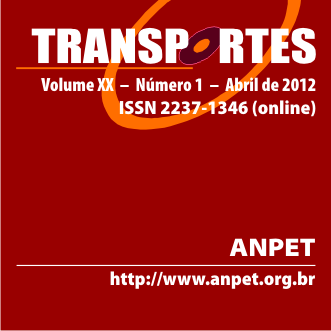Desenvolvimento de um modelo de desempenho de irregularidade longitudinal para a rede de rodovias em tratamento superficial duplo do estado da Bahia
DOI:
https://doi.org/10.4237/transportes.v20i1.432Abstract
Este trabalho apresenta o desenvolvimento de um modelo de previsão de irregularidade longitudinal para a malha rodoviária, em tratamento superficial duplo, do estado da Bahia. Teve como ponto de partida um planejamento fatorial, elaborado com base em informações de um banco de dados de rodovias, fornecido pelo Departamento de Infraestrutura de Transportes da Bahia (DERBA). Os dados de irregularidade longitudinal foram coletados em 2009, quando foram percorridos aproximadamente 3.000 km de rodovias e executados 650 km de levantamentos. Os fatores considerados foram a idade do pavimento, o tráfego e a pluviometria. Foram utilizadas duas formas de análise estatística dos dados para avaliar a significância dos fatores e definir os parâmetros do modelo de desempenho, a análise exploratória de dados e a análise de variância. O modelo obtido foi comparado com outros modelos de previsão da irregularidade longitudinal e apresentou melhor correlação entre valores observados e previstos, evidenciando a validade de sua utilização em análises de redes viárias constituídas por revestimentos asfálticos em tratamento superficial duplo.
Palavras-chave: pavimentos asfálticos, sistemas de gerência, modelos de desempenho, irregularidade longitudinal.
Abstract: This paper presents the development of a roughness performance prediction model for the State of Bahia highway network built in double surface treatment. Its starting point was a factorial design, created based on information from a roadway database pro-vided by the Departamento de Infraestrutura de Transportes da Bahia (DERBA). The roughness data were collected in 2009, when about 3,000 km of roads were travelled and 650 km of surveys were performed. The factors considered were the pavement age, traffic and rainfall. Two statistical analyses were used to assess the significant factors and define the parameters of the roughness performance model, exploratory data analysis and analysis of variance. The model obtained was compared with other performance prediction mod-els, mainly in terms of roughness, and showed better correlation between observed and predicted values, demonstrating the validity of its use in analysis of road networks built with double surface treatment.
Keywords: asphalt pavements, management systems, performance models, roughness.
Downloads
Downloads
Published
How to Cite
Issue
Section
License
Authors who submit papers for publication by TRANSPORTES agree to the following terms:
- The authors retain the copyright and grant Transportes the right of first publication of the manuscript, without any financial charge, and waive any other remuneration for its publication by ANPET.
- Upon publication by Transportes, the manuscript is automatically licensed under the Creative Commons License CC BY 4.0 license. This license permits the work to be shared with proper attribution to the authors and its original publication in this journal.
- Authors are authorized to enter into additional separate contracts for the non-exclusive distribution of the version of the manuscript published in this journal (e.g., publishing in an institutional repository or as a book chapter), with recognition of the initial publication in this journal, provided that such a contract does not imply an endorsement of the content of the manuscript or the new medium by ANPET.
- Authors are permitted and encouraged to publish and distribute their work online (e.g., in institutional repositories or on their personal websites) after the editorial process is complete. As Transportes provides open access to all published issues, authors are encouraged to use links to the DOI of their article in these cases.
- Authors guarantee that they have obtained the necessary authorization from their employers for the transfer of rights under this agreement, if these employers hold any copyright over the manuscript. Additionally, authors assume all responsibility for any copyright infringements by these employers, releasing ANPET and Transportes from any responsibility in this regard.
- Authors assume full responsibility for the content of the manuscript, including the necessary and appropriate authorizations for the disclosure of collected data and obtained results, releasing ANPET and Transportes from any responsibility in this regard.










